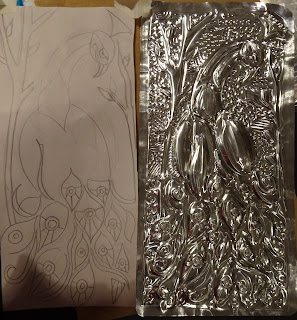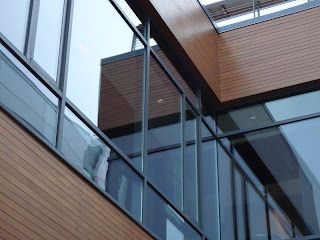The first, Get Deep Relief with Totally Terrific Tooling Foil, was a 1 hour and 50 minute ticketed studio workshop. I'm amazed that the attendees were able to complete such fabulous pieces in the time allotted. The time seemed to fly by very quickly!
I believe the attendee who made the adorable sheep (or is it a lamb?) below plans to add color to help identify his eyes. I think it will be really cool!
Here is the class, learning the basics, and getting started.
The pic below is someone looking at some of my samples.
And a few more fabulous pieces made by attendees.
I'm not going to go into process details here, because they are posted previously on this blog. You can find my video tutorials for working with tooling foil HERE, and you can find a link to a handout called "Oh What a Relief" on my Document Weblinks tab, HERE. To see pics from last year's tooling foil workshop at NAEA, go HERE.
Tons of samples / examples!
My second workshop, Using the Unexpected, was a slide presentation, where I talked about using materials such as toothpaste for an imitation batik resist (example in the pic below), roofing felt as a painting surface, Sheetrock for relief carving, sand as a textural medium for paint, shaving cream for marbling, and more.
It was a nice big room with most of the seats filled. I didn't count, but based on the number of rows of chairs, I think there were about 150 people there!! To access the handout and a PDF of my slide presentation, you can again find them on my Documents Weblinks tab on this blog, HERE.
I really enjoyed teaching the workshops this year, and I think my attendees were mostly quite happy! But unfortunately there is always a downside, and I want to share that with you as well. In my tooling foil workshop, during the hectic closing minutes, some visitors stopped in and looked around, and took some pictures. I should have chased them out, but I thought perhaps they had friends in the workshop. Unfortunately, I learned the next day that one of them had stolen the kit of materials from one of my attendees. How awful! With 6 or 7 thousand art teachers at the convention, there'd be no way to ever find or identify them.
Then, the next day, someone placed a recording device on the front table in my workshop, to record my presentation, and forgot to pick it up at the end. It's usually me that leaves things behind and loses them at conventions, so I feel very badly for the gentleman who was recording my presentation to bring back to the rest of his department. I hope he is able to recover it!



















































